1821-1907 Lucretia Bradley Hubbell
Lucretia Bradley Hubbell was a creative, imaginative woman who led a rich, full, and colorful life. The story of her, her husband Algernon S. Hubble, and adopted daughter exemplifies how a bold Norwich couple in the late 1800s lived a unique, unconventional life. She spent the last 34 years of her life in Norwich as an advocate for community development, a medical practitioner, a patent medicine developer, a regional lecturer, and a mother. Before moving to Norwich, at age 34, Lucretia became the first woman in the United States to fly solo in a gas-filled balloon.
The fountain/horse-watering trough, shown on the left, sat in Franklin Square from 1889 to 1907. It served as a watering trough for the horse trolley line, a community drinking fountain, and watering mecca for dogs, cats, and birds. The article printed in the Norwich Bulletin discusses how Lucretia Bradley Hubbell influenced the design of the structure. Throughout the two-year period of design, construction, and installation of the fountain, Lucretia persisted in adding features to the design that would benefit “man and bird and beast.” According to the article: “When she first broached the subject of making those little animal troughs her views were simply laughed at, but by her persistent effort that found was made a perfect servant for all God’s creatures.”
The beautiful fountain/water trough stands nobly at the head of Chelsea Parade today as a gentle reminder of days gone past.
The 10/25/1906 Norwich Bulletin article is shown on the right.
*Place cursor over images to magnify
Lucretia was born in Hopkinton, RI on May 7, 1821. At the time of her birth, she had 3 older sisters aged 8, 13 and 15. At the age of four, Lucretia’s mother died and one of her sisters, Abby Ann, died five years later. Abby is buried in Hopkinton, RI, so it is most probable that Lucretia lived in Hopkinton in the year 1830.
Twenty-four years later, at the age of 34, Lucretia was unmarried and was very adventurous. She travelled from Connecticut to Easton PA and visited Mr. John Wise, a famed aeronaut, manufacturer of gas-filled balloons, and pioneer in the field of ballooning. During the visit she purchased a “considerably worn” balloon for $100 from Wise. At the time of purchase, he advised her that the balloon needed to be well oiled before being used. In his book, Through the Air, he wrote, “Miss Bradley was a woman of more than ordinary qualifications, active and elastic as a deer, and possessed of a spirit of determination that knew no discouragement in anything she undertook. ‘The Eastonian’ said of her most truthfully that she was ‘a brave, enthusiastic and accomplished Yankee girl, and didn’t want to be anything else.’ ”
She is shown wearing the costume at her ascension in 1855 in the image on the left.
Several weeks after buying the balloon, she returned to Easton, PA on September 13, 1854, to experience her maiden voyage. Unfortunately, on the morning of the planned flight, she found that hoodlums had learned of her plans and damaged the balloon the night before.
However, Lucretia being determined, made a second attempt in February 1855. She piloted her gas-filled balloon from Easton, over the Delaware River, to Still Valley New Jersey. The flight was approximately 4 miles. Unfortunately, the balloon ripped while she was above the Delaware River. She was the first American woman to do a solo gas-balloon flight. After the balloon popped, she parachuted to safety in New Jersey.
A detailed, full-account of the flight, in Lucretia’s own words, is provided in John Wise’s 1873 book Through the Air. After the flight many newspapers throughout the U.S. published articles chronicling her feat and bravery.
WHAT IS PHRENOLOGY?
*Place cursor over image to magnify
Phrenology is a pseudoscience that involves the measurement of bumps on the skull to predict mental traits. It is based on the concept that the brain is the organ of the mind, and that certain brain areas have localized, specific functions or modules. It is said that the brain is composed of different muscles, so those that are used more often were bigger, resulting in the different skull shapes. This provides reasoning for the common presence of bumps on the skull in different locations. The central phrenological notion that measuring the contour of the skull can predict personality traits has been discredited by empirical research.
Phrenologists divided the whole scalp into oblong and conterminous patches identified by various designations, such as adhesiveness, combativeness, destructiveness, secretiveness, acquisitiveness, constructiveness, self-esteem, love of approbation, cautiousness, benevolence, veneration, conscientiousness, firmness, hope, wonder, ideality, wit, imitativeness, individuality, form perception, size perception, weight perception, color perception, locality perception, number perception, order perception, memory of things, time perception, tune perception, linguistic perception, comparative understanding, and metaphysical spirit.
Lucretia became very interested in phrenology in 1854. It is documented that in late 1854 she presented several lectures on the topic in the Easton, PA area. It is unknown where she learned her trade, but, is believed that she was influenced by her close friend, Dr. Mary Walker. From 1854 through 1870 Lucretia gave lectures about phrenology in New England and Canada.
It was reported in Norwich Board of Trade Quarterly that Lucretia “entertained the large audiences in Treadway’s Hall by lectures on phrenology, physiognomy and physiology and gave laughing gas exhibitions.”
08/31/1870 Announcement
Lucretia and her husband Algernon first appear on the rolls of the Norwich City Directory in 1866. She is listed as a “phrenologist and medical practitioner” and he is listed as an “artist”. In later years, Lucretia is listed as a “doctress,” and Algernon is listed as an “inventor and portrait artist.”
Algernon published an article in the September 19, 1870 issue of the Norwich Daily Advisor entitled, “A Guide to Life and Character, Containing a Chart of Phrenological Developments of – Given by Lucretia Bradley Hubbell, Practical Phrenologist, 1864”
In September 1870 Lucretia presented a series of three lectures in Jewett City. One of the newspaper articles is shown on the left.
In 1883 she developed a Trademark Medicine Treatment No. 9,962 named “Spore-Killer.” It has also been reported that, in the same time-frame, Lucretia developed an anti-bilious medication.
The development of Norwich’s Hubbell family, and their creative endeavors is unusual. It is unknown when, where, or how Algernon and Lucretia first met. Little is know of Algernon’s early years, but it is documented that he was an “orator” living in New Haven before their marriage. Lucretia was a well-known, public figure living in New London before their marriage.
*Place cursor over image to magnify
In 1858 they were married at Lucretia’s close friend, famed Civil War Dr. Mary Walker’s residence in Rome, New York. They were married in an unconventional manner. They had a Friends’ marriage ceremony, in which they married themselves. At the time of their marriage Algernon was 21 years-old and Lucretia was 37 years-old.
After 18 years of marriage, Lucretia at age 56 and Algernon at age 40, adopted a 17 year-old girl in 1877. Ida Snow was an orphan (her mother died when Ida was 6 years old). Ida had been boarding at the Hubbell residence on Franklin Street for many years. Ida never married and continued living with Algernon after Lucretia’s death in 1907.
The entire arm of Norwich’s Hubbell family, Richard, Algernon, Lucretia, and Ida are buried together in the Yantic Cemetery. Their gravestone is shown on the left.
Acknowledgements
“Through the Air,” 1873, by John Wise
“Propriety Medicine: Treatment No. 9,962,” Official Gazette of the U.S. Patent Office Vol. 23 No. 3, p 196 (01/16/1883), U.S. Patent Office
“The Fountain and Birds and Beasts,” Norwich Bulletin (10/25/1906)
“Fountain in Norwich’s Franklin Square”, circa 1890, Public Domain, colorized by Bruce Noland (2024).
“Explosion of Miss Bradley’s Balloon,” (1873). Original art by John Wise, colorized by Bruce Noland (2024).
The complete list of sources may be found by clicking the “Bibliography” button, and, then typing “Lucretia” in the SEARCH box.
1822-1907 John D. Crocker
John Denison Crocker (1822-1907), of Norwich was a man of many talents. He is best known for his beautiful landscape artistry, however, Crocker was also an inventor.
Leonardo da Vinci developed one of the first file-cutting machines circa 1500, but John D. Crocker designed and produced a new and improved version in Norwich in the nineteenth century. On February 28, 1865 he was granted U.S. patent 46,545 for a new and improved file-cutting machine. The text of his patent begins as:
“To whom it may concern: Be it known that I, JOHN D. CROCKER, of Norwich, New London County, State of Connecticut, have invented a new and Improved Machine for Making Files; and I do hereby declare that the following is a full, clear, and exact description thereof, reference being had to the accompanying drawings, making a part of this specification, in which Figure 1 is …..”
*Place cursor over images to magnify
W.R. Crocker’s 1855 Cork Cutting Machine
CORK-CUTTING MACHINES
John and his younger brother, William, invented, patented and produced several cork-cutting machines. William invented the cork-cutting machine, shown on the left in 1855. This patent was approved 2 years before John L. Mason’s 1857 patent for making “Mason Jar” lids. There was high demand for a wide variety corks for bottles in the 1850s.
John D. Crocker’s first U.S. patent, shown on the right, was for also for a cork-cutting machine. The 1862 patent, approved 7 years after his brother’s patent, presented a significantly more intricate machine.
Their machines were used by a cork-cutting business run by John Hunt Adams at Commonwealth Works.
J.D. Crocker’s 1862 Cork Cutting Machine
John D. Crocker c1885
John D. Crocker spent most of his life in Norwich. In 1883 his house was listed at 103 Franklin and his “Crocker File Works” shop was located across the street, very near local gun manufacturers. The proprietor of Crocker File Works was Herman D. Raillon.
At twelve, Crocker was apprenticed to a silversmith. He left that trade to work at the shop of a furniture maker and restorer. While there, he was captivated by a portrait brought to the shop for varnishing. At the age of seventeen he became determined to become a portrait painter. Sources describe that Crocker sought advice, and perhaps lessons, from the respected artist Charles Lanman of Norwich.
Examples of Crocker’s fine artistry are on display at the Slater Museum in Norwich.
These three views of Norwich were painted by Crocker in 1853
*Place cursor over images to magnify
The photo gallery below shows all five of Crocker’s U.S. patents. His patents include: an 1862 cork-cutting machine, an 1865 file-cutting machine, an 1870 picture frame, an 1870 canvas stretcher, and an 1873 friction clutch pulley.
U.S. PATENTS
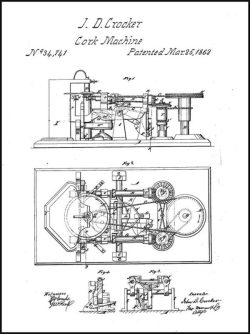
1862 Cork Machine

1865 File Cutting Machine
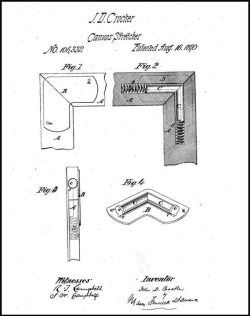
1870 Canvas Stretcher
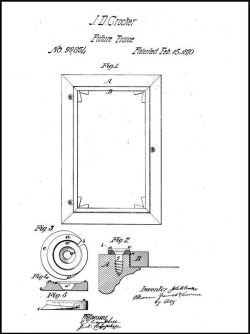
1870 Picture Frame
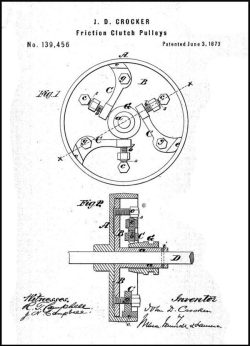
1873 Clutch Pulley
John D. Crocker was also a purveyor of “Crocker’s Magical Stomach Powders.” His powder was advertised to be “A Sure Cure for Indigestion and Bowel Difficulties.”
It is interesting to note the Crocker lived next door (on Franklin Street) to Algernon and Lucretia Hubbell in 1872. Algernon was also a portrait artist and inventor, and, Lucretia also created and sold an anti-bilious potion.
J.D. Crocker married Harriet E. Dillaby in 1849. They had eight children. John and his wife are buried in Norwich’s Yantic Cemetery.
Acknowledgements
“John Denison Crocker: Renaissance Man,” (2005), by Vivian Zoë, Newsletter of the Slater Museum, Fall 2005
“John Denison Crocker (1822-1907),” FindAGrave.com
“1883 Stedman’s Directory of the City and Town of Norwich and That Part of the Town of Preston Adjoining the City of Norwich,” p 63, by John Stedman
The complete list of sources may be found by clicking the “Bibliography” button, and, then typing “Crocker” in the SEARCH box.
The complete description of all his patents may be viewed by clicking the “Patents” button, and, then typing “Crocker” in the SEARCH box.
1829-1906 William H. Page
William H. Page was born in Tilton, NH on March 14, 1829. He was a creative businessman, inventor, newspaper reporter and author. His business endeavors included Page’s City Gardens (a fresh produce sales enterprise), a wood type manufacturing company, two heater manufacturing companies, and a heating supply company.
He is most well-known for his inventions related to the wood type letterpress industry. He was the most influential wood type manufacturer of the nineteenth century.
At age 14, he trained as a printer’s apprentice in Vermont and worked as a traveling printer between 1843-1849. Later, he worked as a reporter for several newspapers in New England and New York City before taking a job in 1853 with the Norwich Tribune newspaper in Norwich.
*Place cursor over any image to magnify
Over the next two years, while working for the newspaper, Page learned wood engraving techniques. In February 1855, he moved to South Windham to work as a type trimmer and cutter, manufacturing wood type for John G. Cooley. The next year, Page purchased a defunct wood type production company in Willimantic and moved its equipment to Greeneville.
While a resident of Norwich, he was awarded 21 U.S. patents. Fifteen of the patents were associated with heating, steam and water boilers. The portable steam boiler, shown on the right, was patented, manufactured, and sold by the Wm. H. Page Boiler Company. The manufacturing facility was located in Greeneville.
However, the six patents (dated 1887-1889) associated with manufacturing processes of wood type are most impressive and most well known. The W.H. Wood Type Company was located on Franklin Street.
His wood type company became the largest manufacturer of wood type in the United States. Page and his employees pioneered the use of chromatic transparent inks creating typography with high visual impact for posters and advertisements created on a letterpress machine.
Wood Type
The word “type” is defined as: A piece of metal, or wood, with a raised letter, character, or pattern on its upper-face for use in a letterpress.
The overwhelming majority of type used in the nineteenth century was made of metal and was used to print newspaper. However, posters and large format advertisements often used wood type, such as shown on the left.
William Page invented tools and processes that were used to make and use wood type. He also created a large variety of typeface styles (a.k.a. fonts). His company sold wood type to many printing houses throughout the United States. In 1885, the W.H. Page Wood Type Company was located at 292-296 Franklin Street (current home of Wiese Construction) .
Wood Type Patents & Patterns
The gallery of images provided below contains select pages from William H. Page’s company book, “Specimens of Chromatic Wood Type, Borders, Etc.” (1874). Chromatic types, which were made to print in two or more colors, were first produced as wood type by Edwin Allen.
The gallery also contains images of all six of William H. Page’s wood type and printing related patents that were awarded to him while a resident of Norwich. His first awarded patent was for the design of a condensed German script ~ US Design Patent No. 1,869 on November 24, 1863.

1863
German Script Design

1874 Wood Type
Advertisement
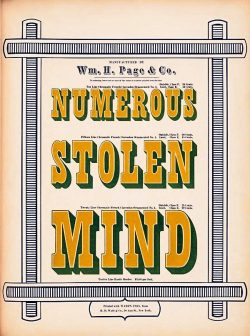
1874 Wood Type
Advertisement
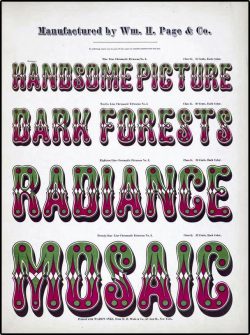
1874 Wood Type
Advertisement
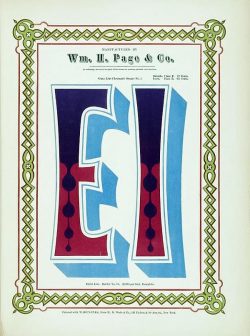
1874 Wood Type
Advertisement
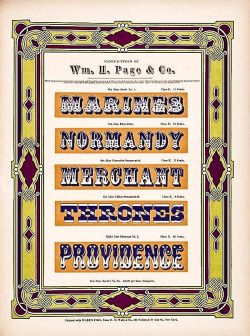
1874 Wood Type
Advertisement
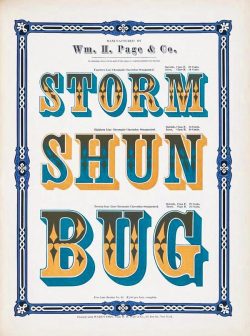
1874 Wood Type
Advertisement
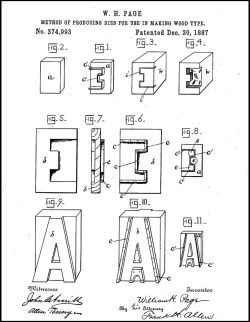
1887 Wood Type Die
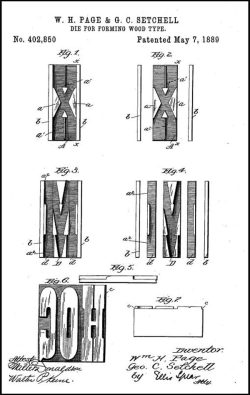
1889 Wood Type Die
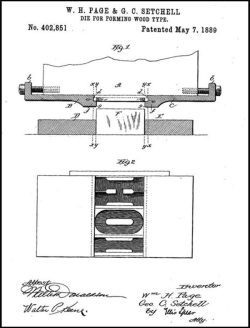
1889 Wood Type Die
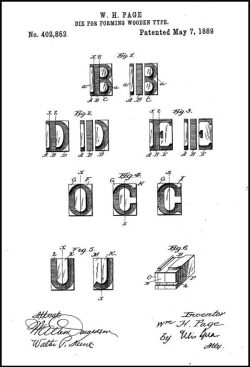
1889 Wood Type Die
While in Norwich, William H. Page became interested in designing and building boilers and steam heaters. In 1876, Page incorporated a new business, the William H. Page Boiler Company. Its manufacturing facility was located at 292-296 Franklin.
After Page patented a steam heater in 1879, he founded the Page Steam Heating Company. The company’s manufacturing facility was located at the corner of South Golden Street and North Main Street.
His 1882 steam radiator patent led him to establish the Combination Company, a steam heating supply business. In May 1883, Page also incorporated the Victor Heating Company. Page was listed as the president of the company, and the address matched the address listed as co-located with the W.H. Page Wood Type Company (112 Franklin Street).
William H. Page’s patents related to boilers and steam heaters are all shown in the photo gallery below.
Boiler & Steam Heater U.S. Patents
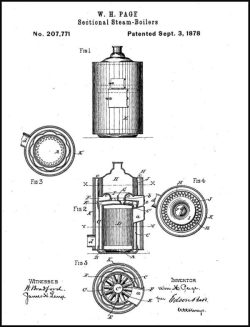
1878 Steam Boiler
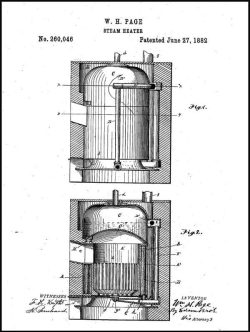
1882 Steam Heater
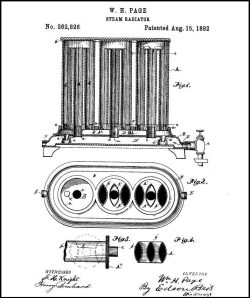
1882 Steam Radiator
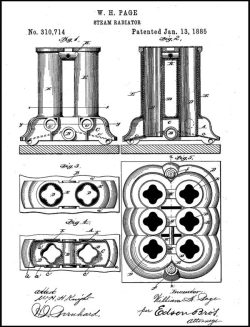
1885 Steam Radiator

1885 Steam Radiator
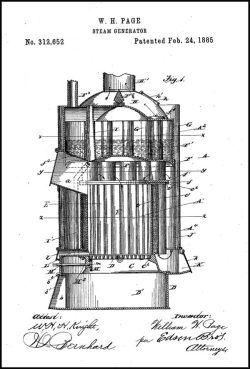
1885 Steam Radiator
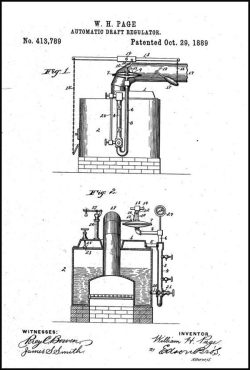
1889 Draft Regulator
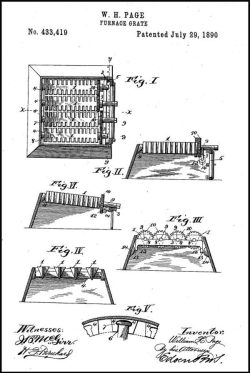
1890 Furnace Grate
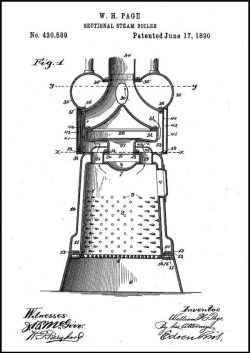
1890 Steam Boiler
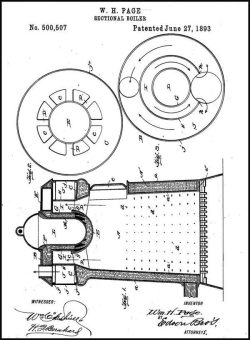
1893 Boiler
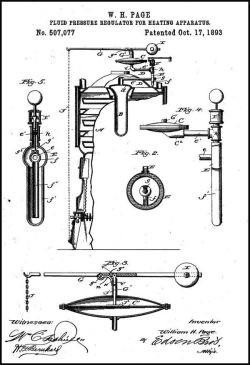
1893 Pressure Regulator
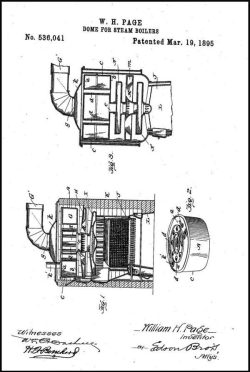
1895 Boiler Dome

1895 Boiler
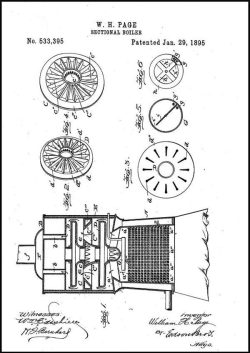
1895 Boiler
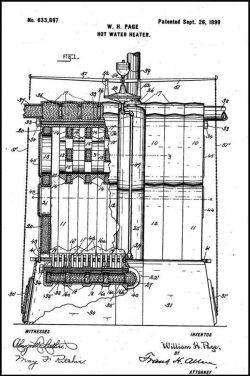
1885 Steam Radiator
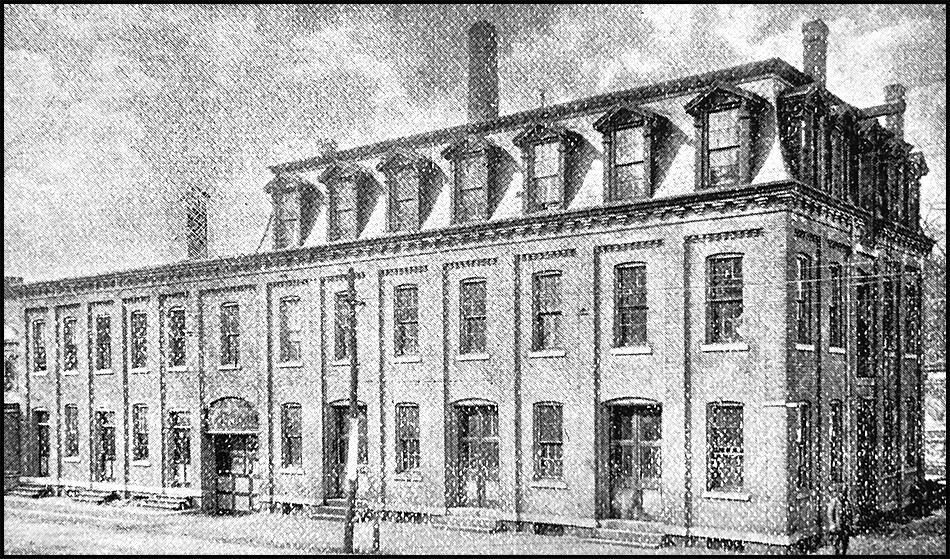
William Page sold his wood type business in 1891 but continued in the heater production business for the rest of his life. The William H. Page Boiler Company continued doing business until 1932 (26 years after he died.)
On November 20, 1855, William H. Page and Catherine Elizabeth Hovey Page were married. The couple had eight children during their fifty years of marriage. They lived in a modest Norwich home, near his wood type company, at 20 Grove Street.
William and Elizabeth are buried in Yantic Cemetery along with their children Frederic, Helen, and Lewis.
Acknowledgements
“William Hamilton Page,” by David Shields
“William H. Page Specimen Catalog,” (1874), Public Domain
The complete list of sources may be found by clicking the “Bibliography” button, and, then typing “William H. Page” in the SEARCH box.
The complete description of all his patents may be viewed by clicking the “Patents” button, and, then typing “William H. Page” in the SEARCH box.